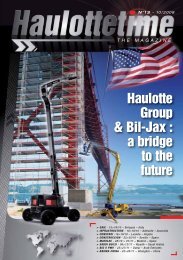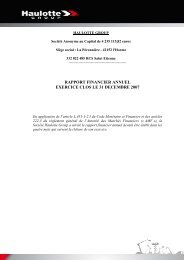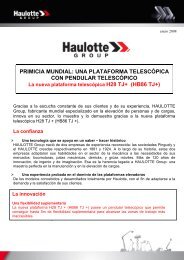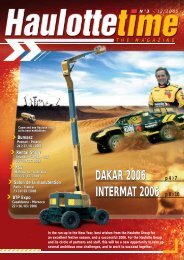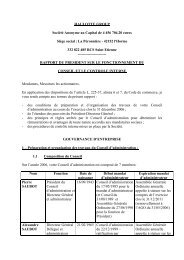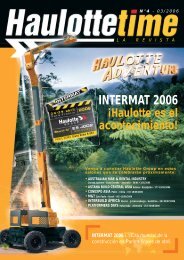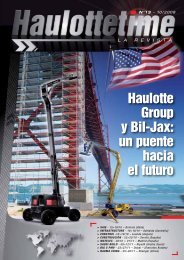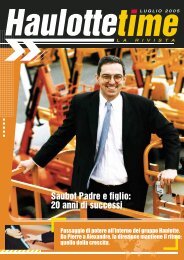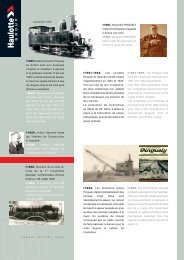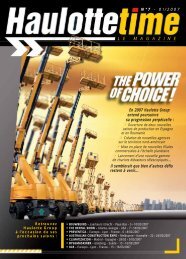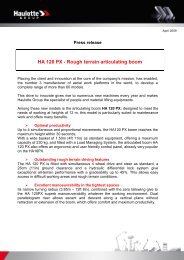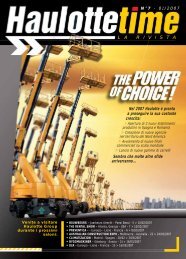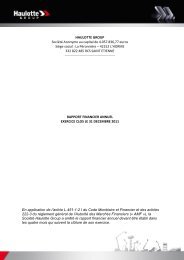2007 - Pinguely Haulotte
2007 - Pinguely Haulotte
2007 - Pinguely Haulotte
You also want an ePaper? Increase the reach of your titles
YUMPU automatically turns print PDFs into web optimized ePapers that Google loves.
Notes to statutory accounts<br />
A. SIGNIFICANT EVENTS<br />
In <strong>2007</strong> sales growth remained<br />
particularly robust, increasing 27% over<br />
fiscal year 2006.<br />
<strong>Haulotte</strong> Group opened three new sales<br />
subsidiaries in the period in Mexico, Dubai<br />
and Argentina.<br />
B. SIGNIFICANT<br />
ACCOUNTING POLICIES<br />
The principles used to determined<br />
earnings remain unchanged as<br />
compared with previous reporting<br />
periods except for the matter listed in<br />
the B.1. paragraph.<br />
Company accounts for the financial year<br />
to December 31st, <strong>2007</strong> have been<br />
prepared on presented persuant to<br />
applicable accounting standards, and<br />
keeping with the principles of prudence<br />
discreteness of accounting periods and<br />
going concern.<br />
The main accounting policies applied<br />
by the company are as follow.<br />
B.1 Change in accounting methods:<br />
acquisition costs of investments<br />
Pursuant to recommendation <strong>2007</strong>-C of<br />
the Comité d’Urgence of the CNC (Conseil<br />
Nationale de la Comptabilite) of 15 June<br />
<strong>2007</strong>, <strong>Haulotte</strong> Group has changed the<br />
accounting method used for acquisition<br />
costs of investments. Commissions, fees<br />
and transfer rights relating the acquisition<br />
of investments were previously expensed.<br />
Starting 1 January <strong>2007</strong>, these costs have<br />
been included in the cost price of the<br />
investments and are subject to a special<br />
tax depreciation over a period of five<br />
years.<br />
This change in accounting policy does<br />
not have a material impact on the<br />
financial statements for the fiscal year<br />
ended 31 December <strong>2007</strong>.<br />
B.2 Fixed assets<br />
Intangible assets are recognized at their<br />
purchase price, excluding incidentals<br />
and financial charges.<br />
Software is amortized on a straight-line<br />
basis over 3 to 7 years according to their<br />
useful lives.<br />
Models and designs are amortized over<br />
5 years.<br />
Goodwill is not subject to amortization.<br />
When necessary, a depreciation expense<br />
is recorded for impairment.<br />
Research and development expenditures<br />
are expensed in the period incurred.<br />
B.3 Property, plant and equipment<br />
Property, plant and equipment are<br />
recognized in the balance sheet at<br />
purchase cost or production cost and<br />
do not include borrowing costs.<br />
Property, plant and equipment are<br />
amortized on a straight-line basis over<br />
their expected useful lives.<br />
When, a given fixed asset includes<br />
components with material relative values<br />
and expected useful lifes that differ<br />
from that of the fixed asset itself,<br />
specific components are identified. These<br />
components are subject to specific<br />
depreciation rates that are specific to<br />
their own expected useful lives.<br />
The basis for calculating the depreciation<br />
is the purchase price less the estimated<br />
residual value, when applicable, at the<br />
end of the expected useful life.<br />
Useful lives are defined for each category<br />
of fixed asset. Usefull lives usually are as<br />
follows:<br />
Plant buildings:<br />
- main component: 40 years<br />
- other components: 10 to 30 years<br />
Building fixtures and improvements<br />
- main component: 10 to 40 years<br />
- other components: 5 to 20 years<br />
Plant equipment:<br />
- main component: 10 to 15 years<br />
- other components: 4 to 40 years<br />
Other installations and equipment:<br />
3 to 20 years<br />
Transportation equipment: 5 years<br />
Computer and office equipment:<br />
3 to 10 years<br />
Office furniture: 3 to 10 years<br />
Residual values and the useful lives are<br />
reviewed at the end of each period and<br />
adjusted when necessary.<br />
When the carrying value of an asset is<br />
lower than its recoverable amount, an<br />
impairment is immediately recorded<br />
reducing it to the latter.<br />
• Regulated tax reserves<br />
Regulated reserves include provisions<br />
for excess tax depreciation applied on<br />
the basis of the most favourable tax rules.<br />
B.4 Financial assets<br />
• Investments and share in subsidiaries<br />
Investments are recognized in the balance<br />
sheet at historical cost that includes the<br />
acquisition costs such as transfer rights,<br />
commissions and fees directly attributable<br />
to the acquisition of the investments.<br />
At year-end their carrying value is<br />
compared with their value in use. This<br />
latter value is determined in reference to<br />
the share in net equity and the earnings<br />
prospects. When applicable, a provision<br />
for impairment is recorded. When<br />
necessary, additional provisions for<br />
impairment are recognized for intra-group<br />
assets (receivables, current accounts) and<br />
a provision for charges is recorded if<br />
necessary.<br />
ENGLISH



